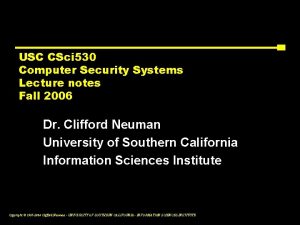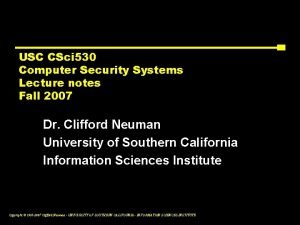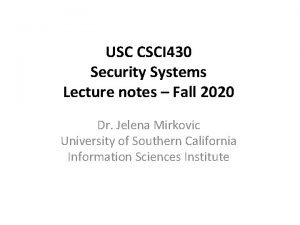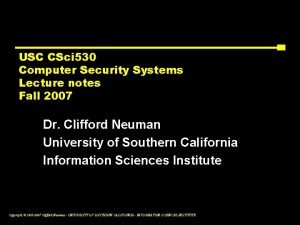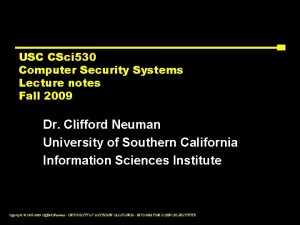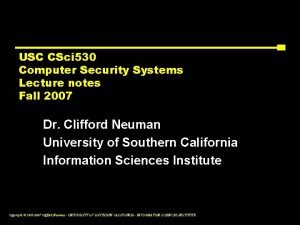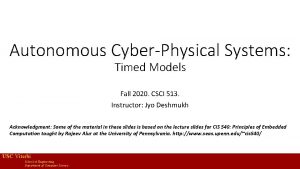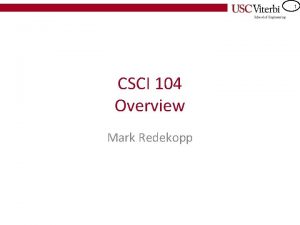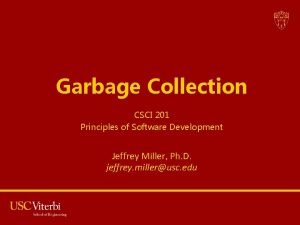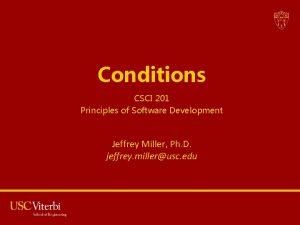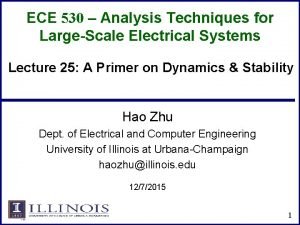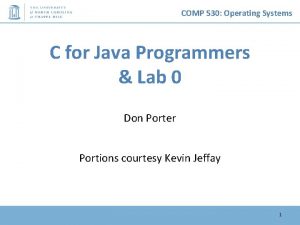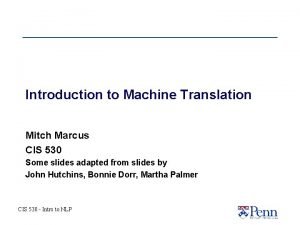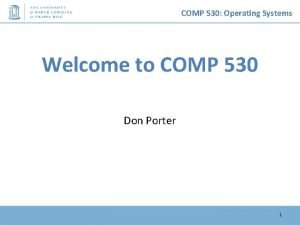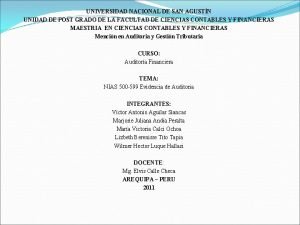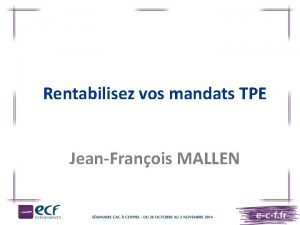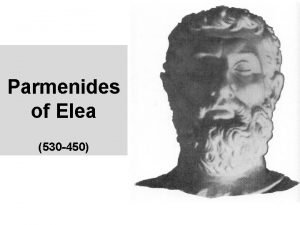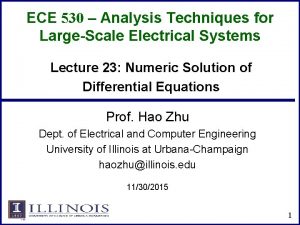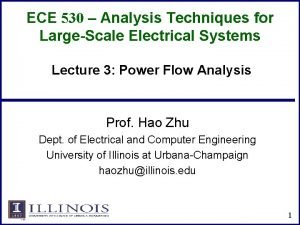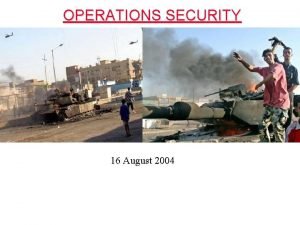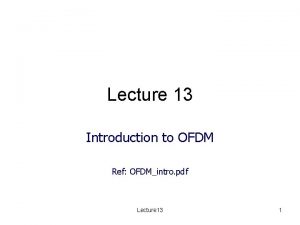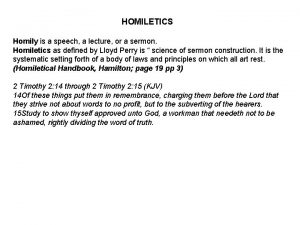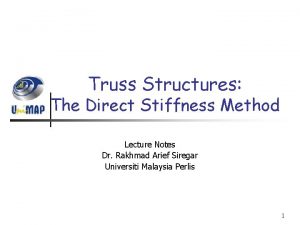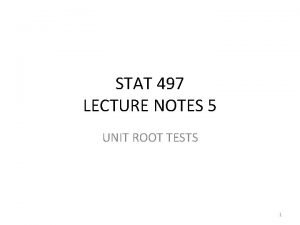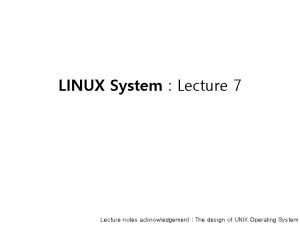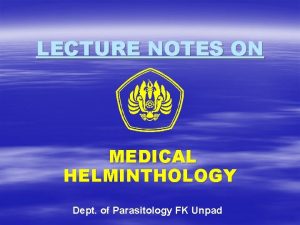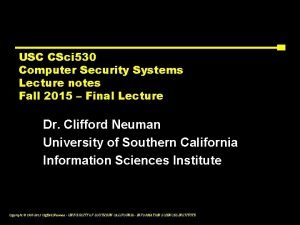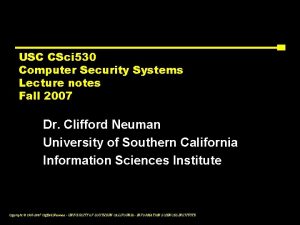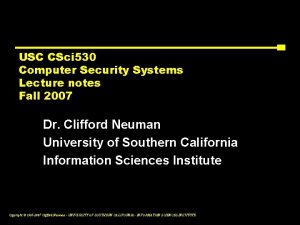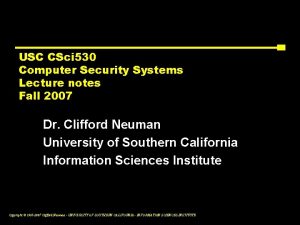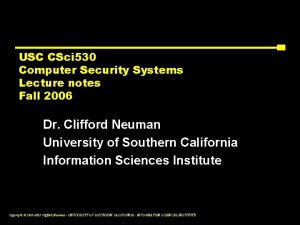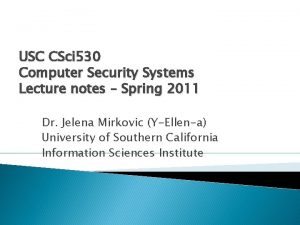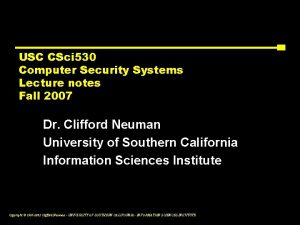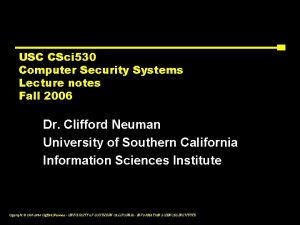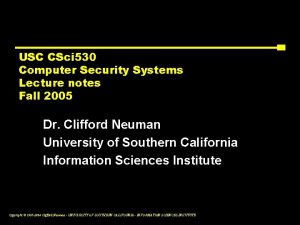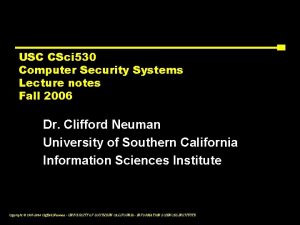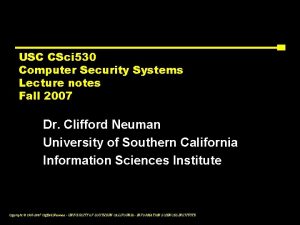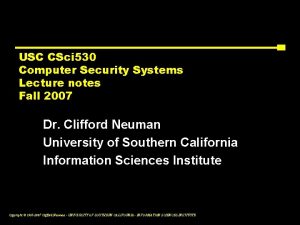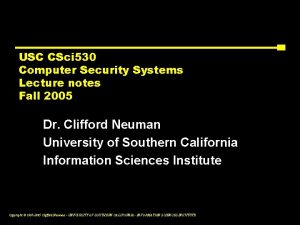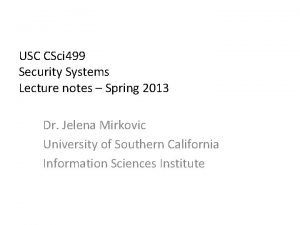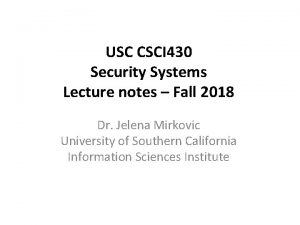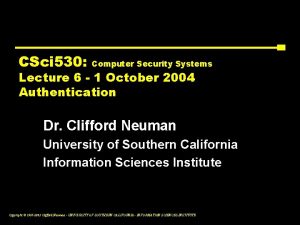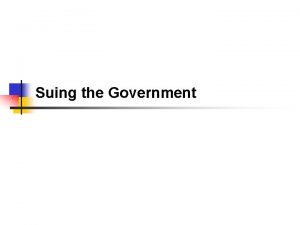USC CSci 530 Computer Security Systems Lecture notes































































- Slides: 63

USC CSci 530 Computer Security Systems Lecture notes Fall 2007 Dr. Clifford Neuman University of Southern California Information Sciences Institute Copyright © 1995 -2007 Clifford Neuman - UNIVERSITY OF SOUTHERN CALIFORNIA - INFORMATION SCIENCES INSTITUTE

Administrative • No lecture next week – Thanksgiving Holiday • Research papers – As of AM yesterday, queue of queries was empty. If you are waiting for response, please resend. • Course Evaluations – In Two weeks (November 30) – I need a volunteer to administer ▪ See me at break or after class • Final two lectures – On topics of your chosing Copyright © 1995 -2007 Clifford Neuman - UNIVERSITY OF SOUTHERN CALIFORNIA - INFORMATION SCIENCES INSTITUTE

CSci 530: Security Systems Lecture 12 – November 16, 2007 Trusted Computing Dr. Clifford Neuman University of Southern California Information Sciences Institute Copyright © 1995 -2007 Clifford Neuman - UNIVERSITY OF SOUTHERN CALIFORNIA - INFORMATION SCIENCES INSTITUTE

COVERED LAST LECTURE Trusted vs. Trustworthy • We trust our computers – We depend upon them. – We are vulnerable to breaches of security. • Our computer systems today are not worthy of trust. – We have buggy software – We configure the systems incorrectly – Our user interfaces are ambiguous regarding the parts of the system with which we communicate. Copyright © 1995 -2007 Clifford Neuman - UNIVERSITY OF SOUTHERN CALIFORNIA - INFORMATION SCIENCES INSTITUTE

COVERED LAST LECTURE A Controversial Issue • Many individuals distrusted computing. • One view can be found at http: //www. lafkon. net/tc/ – An animated short film by Benjamin Stephan and Lutz Vogel Copyright © 1995 -2007 Clifford Neuman - UNIVERSITY OF SOUTHERN CALIFORNIA - INFORMATION SCIENCES INSTITUTE

COVERED LAST LECTURE What is Trusted Computing • Attestation – Includes Trusted path • Separation – Secure storage (data/keys) – Protection of processes • The rest is policy – That’s the hard part – And the controversial part Copyright © 1995 -2007 Clifford Neuman - UNIVERSITY OF SOUTHERN CALIFORNIA - INFORMATION SCIENCES INSTITUTE

COVERED LAST LECTURE Separation of Security Domains • Need to delineation between domains – Old Concept: ▪ Rings in Multics ▪ System vs. Privileged mode – But who decides what is trusted ▪ User in some cases ▪ Third parties in others ▪ Trusted computing provides the basis for making the assessment. Copyright © 1995 -2007 Clifford Neuman - UNIVERSITY OF SOUTHERN CALIFORNIA - INFORMATION SCIENCES INSTITUTE

COVERED LAST LECTURE Trusted Path • We need a “trusted path” – For user to communicate with a domain that is trustworthy. ▪ Usually initiated by escape sequence that application can not intercept: e. g. CTL-ALT-DEL – Could be direct interface to trusted device: – Display and keypad on smartcard Copyright © 1995 -2007 Clifford Neuman - UNIVERSITY OF SOUTHERN CALIFORNIA - INFORMATION SCIENCES INSTITUTE

COVERED LAST LECTURE Communicated Assurance • We need a “trusted path” across the network. • Provides authentication of the software components with which one communicates. Copyright © 1995 -2007 Clifford Neuman - UNIVERSITY OF SOUTHERN CALIFORNIA - INFORMATION SCIENCES INSTITUTE

COVERED LAST LECTURE The Landscape – Early Work • Multics System in late 1960 s. – Trusted path, isolation. • Paper on Digital Distributed System Security Architecture by Gasser, Goldstein, Kauffman, and Lampson. – Described early need for remote attestation and how accomplished. Copyright © 1995 -2007 Clifford Neuman - UNIVERSITY OF SOUTHERN CALIFORNIA - INFORMATION SCIENCES INSTITUTE

COVERED LAST LECTURE The Landscape – Industry • Industry interest in the late 1990 s. • Consortia formed such as the Trusted Computing Group. • Standards specifications, starting with specs for hardware with goal of eventual inclusion in all new computer systems. – Current results centered around attestation and secure storage. Copyright © 1995 -2007 Clifford Neuman - UNIVERSITY OF SOUTHERN CALIFORNIA - INFORMATION SCIENCES INSTITUTE

COVERED LAST LECTURE The Landscape – Applications • Digital Rights Management • Network Admission Control – PC Health Monitoring – Malware detection • Virtualization of world view – VPN Segregation – Process control / SCADA systems • Many other users Copyright © 1995 -2007 Clifford Neuman - UNIVERSITY OF SOUTHERN CALIFORNIA - INFORMATION SCIENCES INSTITUTE

Discussion - Risks • Trusted computing is a tool that can be misused. – If one party has too much market power, it can dictate unreasonable terms and enforce them. • Too much trust in trusted computing. – Attestation does not make a component trustworthy. – Some will rely too much on certifications. Copyright © 1995 -2007 Clifford Neuman - UNIVERSITY OF SOUTHERN CALIFORNIA - INFORMATION SCIENCES INSTITUTE

Discussion - Benefits • Allows systems to be developed that require trustworthy remote components. – Provides protection of data when out of the hands of its owner. • Can provides isolation and virtualization beyond local system. – Provides containment of compromise. Copyright © 1995 -2007 Clifford Neuman - UNIVERSITY OF SOUTHERN CALIFORNIA - INFORMATION SCIENCES INSTITUTE

Discussion – What’s missing • Tools to manage policy – Managing policy was limitation for TC support in Vista • Applications that protect the end user – We need more than DRM and tools to limit what users run. • New architectures and ways of thinking about security. Copyright © 1995 -2007 Clifford Neuman - UNIVERSITY OF SOUTHERN CALIFORNIA - INFORMATION SCIENCES INSTITUTE

Trusted Baggage • So why all the concerns in the open source community regarding trusted computing. – Does it really discriminate against open sources software. – Can it be used to spy on users. Copyright © 1995 -2007 Clifford Neuman - UNIVERSITY OF SOUTHERN CALIFORNIA - INFORMATION SCIENCES INSTITUTE

Equal Opportunity for Discrimination • Trusted computing means that the entities that interact with one another can be more certain about their counterparts. • This gives all entities the ability to discriminate based on trust. • Trust is not global – instead one is trusted “to act a certain way”. Copyright © 1995 -2007 Clifford Neuman - UNIVERSITY OF SOUTHERN CALIFORNIA - INFORMATION SCIENCES INSTITUTE

Equal Opportunity for Discrimination(2) • Parties can impose limits on what the software they trust will do. • That can leave less trusted entities at a disadvantage. • Open source has fewer opportunities to become “trusted”. Copyright © 1995 -2007 Clifford Neuman - UNIVERSITY OF SOUTHERN CALIFORNIA - INFORMATION SCIENCES INSTITUTE

Is Trusted Computing Evil • Trusted computing is not evil – It is the policies that companies use trusted computing to enforce that are in question. – Do some policies violate intrinsic rights or fair competition? – That is for the courts to decide. Copyright © 1995 -2007 Clifford Neuman - UNIVERSITY OF SOUTHERN CALIFORNIA - INFORMATION SCIENCES INSTITUTE

What can we do with TC? • Clearer delineation of security domains – We can run untrusted programs safely. ▪ Run in domain with no access to sensitive resources – Such as most of your filesystem – Requests to resources require mediation by TCB, with possible queries user through trusted path. Copyright © 1995 -2007 Clifford Neuman - UNIVERSITY OF SOUTHERN CALIFORNIA - INFORMATION SCIENCES INSTITUTE

Mediating Programs Today • Why are we so vulnerable to malicious code today? – Running programs have full access to system files. – Why? NTFS and XP provide separation. ▪ But many applications won’t install, or even run, unless users have administrator access. – So we run in “System High” Copyright © 1995 -2007 Clifford Neuman - UNIVERSITY OF SOUTHERN CALIFORNIA - INFORMATION SCIENCES INSTITUTE

Corporate IT Departments Solve this • Users don’t have administrator access even on their own laptops. – This keeps end users from installing their own software, and keeps IT staff in control. – IT staff select only software for end users that will run without administrator privileges. – But systems still vulnerable to exploits in programs that cause access to private data. – Effects of “Plugins” can persist across sessions. Copyright © 1995 -2007 Clifford Neuman - UNIVERSITY OF SOUTHERN CALIFORNIA - INFORMATION SCIENCES INSTITUTE

The next step • But, what if programs were accompanied by third party certificates that said what they should be able access. – IT department can issues the certificates for new applications. – Access beyond what is expected results in system dialogue with user over the trusted path. Copyright © 1995 -2007 Clifford Neuman - UNIVERSITY OF SOUTHERN CALIFORNIA - INFORMATION SCIENCES INSTITUTE

Red / Green Networks (1) • Butler Lampson of Microsoft and MIT suggests we need two computers (or two domains within our computers). – Red network provides for open interaction with anyone, and low confidence in who we talk with. – We are prepared to reload from scratch and lose our state in the red system. Copyright © 1995 -2007 Clifford Neuman - UNIVERSITY OF SOUTHERN CALIFORNIA - INFORMATION SCIENCES INSTITUTE

Red / Green Networks (2) • The Green system is the one where we store our important information, and from which we communicate to our banks, and perform other sensitive functions. – The Green network provides high accountability, no anonymity, and we are safe because of the accountability. – But this green system requires professional administration. – My concern is that a breach anywhere destroys the accountability for all. Copyright © 1995 -2007 Clifford Neuman - UNIVERSITY OF SOUTHERN CALIFORNIA - INFORMATION SCIENCES INSTITUTE

Somewhere over the Rainbow • But what if we could define these systems on an application by application basis. – There must be a barrier to creating new virtual systems, so that users don’t become accustomed to clicking “OK”. – But once created, the TCB prevents the unauthorized retrieval of information from outside this virtual system, or the import of untrusted code into this system. – Question is who sets the rules for information flow, and do we allow overrides (to allow the creation of third party applications that do need access to the information so protected). Copyright © 1995 -2007 Clifford Neuman - UNIVERSITY OF SOUTHERN CALIFORNIA - INFORMATION SCIENCES INSTITUTE

A Financial Virtual System • I might have my financial virtual system. When asked for financially sensitive data, I hit CTLALT-DEL to see which virtual system is asking for the data. • I create a new virtual systems from trusted media provided by my bank. • I can add applications, like quicken, and new participant’s, like my stock broker, to a virtual system only if they have credentials signed by a trusted third party. – Perhaps my bank, perhaps some other entity. Copyright © 1995 -2007 Clifford Neuman - UNIVERSITY OF SOUTHERN CALIFORNIA - INFORMATION SCIENCES INSTITUTE

How Many Virtual Systems • Some examples: – My open, untrusted, wild Internet. – My financial virtual system – My employer’s virtual system. – Virtual systems for collaborations ▪ Virtual Organizations – Virtual systems that protect others ▪ Might run inside VM’s that protect me – Resolve conflicting policies – DRM vs. Privacy, etc Copyright © 1995 -2007 Clifford Neuman - UNIVERSITY OF SOUTHERN CALIFORNIA - INFORMATION SCIENCES INSTITUTE

Digital Rights Management • Strong DRM systems require trust in the systems that receive and process protected content. – Trust is decided by the provider of the content. – This requires that the system provides assurance that the software running on the accessing system is software trusted by the provider. Copyright © 1995 -2007 Clifford Neuman - UNIVERSITY OF SOUTHERN CALIFORNIA - INFORMATION SCIENCES INSTITUTE

Privacy and Anti-Trust Concerns • The provider decides its basis for trust. – Trusted software may have features that are counter to the interests of the customer. ▪ Imposed limits on fair use. ▪ Collection and transmission of data the customer considers private. ▪ Inability to access the content on alternative platforms, or within an open source O/S. Copyright © 1995 -2007 Clifford Neuman - UNIVERSITY OF SOUTHERN CALIFORNIA - INFORMATION SCIENCES INSTITUTE

Trusted Computing Cuts Both Ways • The provider-trusted application might be running in a protected environment that doesn’t have access to the user’s private data. – Attempts to access the private data would thus be brought to the users attention and mediate through the trusted path. – The provider still has the right not to provide the content, but at least the surreptitious snooping on the user is exposed. Copyright © 1995 -2007 Clifford Neuman - UNIVERSITY OF SOUTHERN CALIFORNIA - INFORMATION SCIENCES INSTITUTE

What do we need for TC • Trust must be grounded – Hardware support ▪ How do we trust the hardware ▪ Tamper resistance – Embedded encryption key for signing next level certificates. ▪ Trusted HW generates signed checksum of the OS and provides new private key to the OS Copyright © 1995 -2007 Clifford Neuman - UNIVERSITY OF SOUTHERN CALIFORNIA - INFORMATION SCIENCES INSTITUTE

Privacy of Trusted Hardware • Consider the processor serial number debate over Intel chips. – Many considered it a violation of privacy for software to have ability to uniquely identify the process on which it runs, since this data could be embedded in protocols to track user’s movements and associations. – But Ethernet address is similar, although software allows one to use a different MAC address. – Ethernet addresses are often used in deriving unique identifiers. Copyright © 1995 -2007 Clifford Neuman - UNIVERSITY OF SOUTHERN CALIFORNIA - INFORMATION SCIENCES INSTITUTE

The Key to your Trusted Hardware • Does not have to be unique per machine, but uniqueness allows revocation if hardware is known to be compromised. – But what if a whole class of hardware is compromised, if the machine no longer useful for a whole class of applications. Who pays to replace it. • A unique key identifes specific machine in use. – Can a signature use a series of unique keys that are not linkable, yet which can be revoked (research problem). Copyright © 1995 -2007 Clifford Neuman - UNIVERSITY OF SOUTHERN CALIFORNIA - INFORMATION SCIENCES INSTITUTE

Non-Maskable Interrupts • We must have hardware support for a non-maskable interrupt that will transfer program execution to the Trusted Computing Base (TCB). – This invokes the trusted path Copyright © 1995 -2007 Clifford Neuman - UNIVERSITY OF SOUTHERN CALIFORNIA - INFORMATION SCIENCES INSTITUTE

The Hardware Basis • Trusted computing is proof by induction – Each attestation stage says something about the next level – Just like PKI Certification hierarchy • One needs a basis step – On which one relies – Hardware is that step ▪ (well, second step anyway) Copyright © 1995 -2007 Clifford Neuman - UNIVERSITY OF SOUTHERN CALIFORNIA - INFORMATION SCIENCES INSTITUTE

Hardware Topics • Trusted Platform Module • Discussion of Secure Storage • Boot process Copyright © 1995 -2007 Clifford Neuman - UNIVERSITY OF SOUTHERN CALIFORNIA - INFORMATION SCIENCES INSTITUTE

Trusted Platform Module • Basically a Key Storage and Generation Device • Capabilities: – Generation of new keys – Storage and management of keys ▪ Uses keys without releasing Copyright © 1995 -2007 Clifford Neuman - UNIVERSITY OF SOUTHERN CALIFORNIA - INFORMATION SCIENCES INSTITUTE

Trusted Platform Module (TPM)? Smartcard-like module on the motherboard that: • Performs cryptographic functions • • • – RSA, SHA-1, RNG – Meets encryption export requirements Can create, store and manage keys – Provides a unique Endorsement Key (EK) – Provides a unique Storage Root Key (SRK) Performs digital signature operations Holds Platform Measurements (hashes) Anchors chain of trust for keys and credentials Protects itself against attacks TPM 1. 2 spec: www. trustedcomputinggroup. org Slide From Steve Lamb at Microsoft Copyright © 1995 -2007 Clifford Neuman - UNIVERSITY OF SOUTHERN CALIFORNIA - INFORMATION SCIENCES INSTITUTE

Why Use A TPM? • • • Trusted Platforms use Roots-of-Trust – A TPM is an implementation of a Root-of-Trust A hardware Root-of-Trust has distinct advantages – Software can be hacked by Software ▪ Difficult to root trust in software that has to validate itself – Hardware can be made to be robust against attacks ▪ Certified to be tamper resistant – Hardware and software combined can protect root secrets better than software alone A TPM can ensure that keys and secrets are only available for use when the environment is appropriate – Security can be tied to specific hardware and software configurations Slide From Steve Lamb at Microsoft Copyright © 1995 -2007 Clifford Neuman - UNIVERSITY OF SOUTHERN CALIFORNIA - INFORMATION SCIENCES INSTITUTE

Endorsement Key • Every TPM has unique Endorsement key – Semi-root of trust for system – Generated and installed during manufacture ▪ Issues – Real root is CA that signs public key associated with Endorsement key Copyright © 1995 -2007 Clifford Neuman - UNIVERSITY OF SOUTHERN CALIFORNIA - INFORMATION SCIENCES INSTITUTE

Using Encryption for Atestation • Extend – Add data to a PCR – 20 byte hashed into current PCR – As each module loaded its hash extends the PCR • Quote – Sign current value of PCR Copyright © 1995 -2007 Clifford Neuman - UNIVERSITY OF SOUTHERN CALIFORNIA - INFORMATION SCIENCES INSTITUTE

Secure Storage • Full Disk Encryption – Key in register in disk – Or key in TPM and data encrypted/decrypted by TPM • Seagate Drive uses register in Disk – Key must be loaded – User prompt at BIOS – Or managed by TPM ▪ But OS image maybe on disk, how to get Copyright © 1995 -2007 Clifford Neuman - UNIVERSITY OF SOUTHERN CALIFORNIA - INFORMATION SCIENCES INSTITUTE

OS Support for Trusted Computing (1) • Separation of address space – So running processes don’t interfere with one another. • Key and certificate management for processes – Process tables contain keys or key identifiers needed by application, and keys must be protected against access by others. – Processes need ability to use the keys. Copyright © 1995 -2007 Clifford Neuman - UNIVERSITY OF SOUTHERN CALIFORNIA - INFORMATION SCIENCES INSTITUTE

OS Support for Trusted Computing (2) • Fine grained access controls on persistent resources. – Protects such resources from untrusted applications. • The system must protect against actions by the owner of the system. Copyright © 1995 -2007 Clifford Neuman - UNIVERSITY OF SOUTHERN CALIFORNIA - INFORMATION SCIENCES INSTITUTE

Disk Layout & Key Storage Windows Partition Contains § Encrypted OS § Encrypted Page File § Encrypted Temp Files § Encrypted Data § Encrypted Hibernation File Where’s the Encryption Key? 1. SRK (Storage Root Key) contained in TPM 2. SRK encrypts VEK (Volume Encryption Key) protected by TPM/PIN/Dongle 3. VEK stored (encrypted by SRK) on hard drive in Boot Partition VEK 2 SRK 1 Windows Boot 3 Slide From Steve Lamb at Microsoft Boot Partition Contains: MBR, Loader, Boot Utilities (Unencrypted, small) Copyright © 1995 -2007 Clifford Neuman - UNIVERSITY OF SOUTHERN CALIFORNIA - INFORMATION SCIENCES INSTITUTE

Bit. Locker™ Architecture Static Root of Trust Measurement of early boot components Slide From Steve Lamb at Microsoft Copyright © 1995 -2007 Clifford Neuman - UNIVERSITY OF SOUTHERN CALIFORNIA - INFORMATION SCIENCES INSTITUTE

Vista co-existence Slide From Steve Lamb at Microsoft • Bit. Locker encrypts Windows partition only • You won’t be able to dual-boot another OS on the same partition • OSes on other partitions will work fine • Attempts to modify the protected Windows partition will render it unbootable – Replacing MBR – Modifying even a single bit Copyright © 1995 -2007 Clifford Neuman - UNIVERSITY OF SOUTHERN CALIFORNIA - INFORMATION SCIENCES INSTITUTE

No more running as root or administrator • You may have full access within a virtual system, and to applications within the system it may look like root, but access to other virtual systems will be mediated. • User. ID’s will be the cross product of users and the virtual systems to which they are allowed access. • All accessible resources must be associated with a virtual system. Copyright © 1995 -2007 Clifford Neuman - UNIVERSITY OF SOUTHERN CALIFORNIA - INFORMATION SCIENCES INSTITUTE

CSci 530: Security Systems Lecture 13 – November 30, 2007 Select Topics and Review (ADVANCE SLIDES) Dr. Clifford Neuman University of Southern California Information Sciences Institute Copyright © 1995 -2007 Clifford Neuman - UNIVERSITY OF SOUTHERN CALIFORNIA - INFORMATION SCIENCES INSTITUTE

Requested Topics • • Landscape of attacks (glossary) Risk Analysis How are attacks funded? Security Case Studies – I’ll use these as a basis for review Copyright © 1995 -2007 Clifford Neuman - UNIVERSITY OF SOUTHERN CALIFORNIA - INFORMATION SCIENCES INSTITUTE

Glossary of Attacks This is not a complete list • Availability – Denial of Service (Do. S AND DDo. S) ▪ Over consumption of resources – Network, ports, etc – Take down name servers, other critical components ▪ Exploits to crash system ▪ Cache poisoning Copyright © 1995 -2007 Clifford Neuman - UNIVERSITY OF SOUTHERN CALIFORNIA - INFORMATION SCIENCES INSTITUTE

Glossary of Attacks This is not a complete list • Confidentiality – Eavesdropping – Key Cracking – Exploiting Key Mismanagement – Impersonation ▪ Exploiting protocol weakness ▪ Discovered passwords ▪ Social Engineering – Exploiting mis-configurations Copyright © 1995 -2007 Clifford Neuman - UNIVERSITY OF SOUTHERN CALIFORNIA - INFORMATION SCIENCES INSTITUTE

Glossary of Attacks This is not a complete list • Integrity – Breaking Hash Algorithms – Exploiting Key Mismanagement – Impersonation ▪ Exploiting protocol weakness ▪ Discovered passwords ▪ Social Engineering – Exploiting mis-configurations Copyright © 1995 -2007 Clifford Neuman - UNIVERSITY OF SOUTHERN CALIFORNIA - INFORMATION SCIENCES INSTITUTE

Glossary of Attacks This is not a complete list • Miscellaneous – Spam – Phishing – Malware attacks ▪ Spyware ▪ Viruses ▪ Worms ▪ Trojan Horse – Man in the middle Copyright © 1995 -2007 Clifford Neuman - UNIVERSITY OF SOUTHERN CALIFORNIA - INFORMATION SCIENCES INSTITUTE

Risk Management • Security is not absolute • One must balance: – Likelihood of attack – Defense costs – Cost of lost opportunity – Cost on users – Losses from attack • Successful Risk Management – Considers ways to affect all of the above Copyright © 1995 -2007 Clifford Neuman - UNIVERSITY OF SOUTHERN CALIFORNIA - INFORMATION SCIENCES INSTITUTE

Funding of Attacks • Used to be unfunded – Bragging rights • Now networks and underground economy – Organized crime – Direct gain from attack Copyright © 1995 -2007 Clifford Neuman - UNIVERSITY OF SOUTHERN CALIFORNIA - INFORMATION SCIENCES INSTITUTE

Hypothetical Case Studies • Past exams – Electronic voting (Fall 2004) – Medical records (Fall 2003) – Intrusion Detection and Response (Fall 2005) Copyright © 1995 -2007 Clifford Neuman - UNIVERSITY OF SOUTHERN CALIFORNIA - INFORMATION SCIENCES INSTITUTE

Electronic Voting You have been asked to design a system to support the collection and counting of votes for the next election. In particular, you have been asked to design a system that will accurately tabulate votes entered by voters at poling places throughout the state and to transmit those votes to the county clerk of each county where the totals will be tabulated. (a) Threats. What are threats in such a system? What can go wrong? (b) Requirements. What are the requirements for authentication, authorization, assurance, audit, and privacy? Explain who and what must be authenticated, what authorizations are required, what assurance is needed for the software, and what kind of records must be maintained (as well as what kinds of records should not be maintained). (c) Considering the requirements listed above, and how they relate to the assurance problem, i. e. how can steps taken for authentication, authorization and audit be used to ensure that the software has not been modified to improperly record or transmit votes? (d) What technologies proposed for digital rights management be used to provide stronger assurance that the system’s integrity has not been compromised. What is similar about the two problems, and how would such technologies be applied to the voting problem. Copyright © 1995 -2007 Clifford Neuman - UNIVERSITY OF SOUTHERN CALIFORNIA - INFORMATION SCIENCES INSTITUTE

Medical Records • You have been hired as a consultant to advise on the design of a security mechanism that will be used to protect patient data in a new medical records system. This system will manage and support the transmission of patient records, including very large images files for X-rays, MRI, CAT-scans and other procedures. The system must provide appropriate levels of protection to meet HIPAA privacy regulations, and it must allow the access to records needed by physicians and specialists to which patients are referred. (a) Describe appropriate requirements for confidentiality, integrity, accountability, and reliability/availability in such a system. (b) In what part's) of the system (e. g. , where in the protocol stack would you include support for each of the requirements identified in (a)? Why would you place mechanisms where you suggested; what were the issues you considered? (c) What security mechanisms and approaches to implement those mechanisms would you use to meet the requirements in (a) as implemented in the parts of the system you identified in (b)? Copyright © 1995 -2007 Clifford Neuman - UNIVERSITY OF SOUTHERN CALIFORNIA - INFORMATION SCIENCES INSTITUTE

Intrusion Detection and Response • You have been asked to design a system that will provide effective response to new attacks. The system you design will have two components, an intrusion detection component designed to detect attacks, and a dynamic policy enforcement mechanisms that will dynamically adjust policies based on what is learned about attacks from the intrusion detection component. Your system is supposed to provide an effective defense against viruses, worms, as well as attacker targeted penetration attempts to the systems in your organization. Copyright © 1995 -2007 Clifford Neuman - UNIVERSITY OF SOUTHERN CALIFORNIA - INFORMATION SCIENCES INSTITUTE

Review - Topics • • • Cryptography Key Management Identity Management (and Authentication) Policy (and Authorization) Attacks – Classic – The human element • Defenses – Firewalls, Intrusion Detection and Response, Encryption, Tunnels, Defenses to Malware • Architectures and Trusted Computing Copyright © 1995 -2007 Clifford Neuman - UNIVERSITY OF SOUTHERN CALIFORNIA - INFORMATION SCIENCES INSTITUTE

Current Event Seagate Ships Virus Laden Hard Drives Robert Mc. Millan, Computerworld, 11/13/2007 If you bought one of Seagate's Maxtor Basics consumer hard drives recently, check it for viruses. Especially if you're a gamer. Seagate is warning that a "small number" of its Maxtor Basics Personal Storage 3200 hard drives recently shipped with the Virus. Win 32. Auto. Run. ah virus, malicious software that "searches for passwords for online games and sends them to a server located in China, " according to a note posted on the Seagate Web site. Only drives purchased since August 2007 are affected, Seagate said. The hard drive maker is blaming an unnamed subcontractor, located in China, for the problem. Seagate said it learned about the problem from antivirus vendor Kaspersky Lab. According to published reports, Seagate has had problems with Maxtor Basics drives sold over the past few months in the Netherlands and Taipei. On Monday, the Taipei Times reported that Taiwanese distributor Xander International had discovered that 1, 800 Maxtor Basics 500 G-byte hard drives were affected, all manufactured in Thailand. When contacted by IDG News Service on Monday, Seagate offered few additional details on the problem, except to say that it was investigating the cause of the infection and that it was offering a 60 -day free trial of Kaspersky's anti-virus software through the Seagate Web site. "The trial version of the Kaspersky anti-virus software is capable of identifying and removing the virus, " spokesman Forrest Monroy said via e-mail. The virus scans the hard drive for password information on World of Warcraft as well as a number of Chinese games such as QQ, WSGame, and Ask. Tao, Seagate said. Trend Micro researcher Paul Ferguson said that while the password-collecting servers may appear to be located in China, they are actually located in Dallas and Korea. This isn't the first time that subcontractors have been blamed for virus infections on storage media. A year ago, Apple shipped a number of Video i. Pod systems infected with a virus. The company blamed a contract manufacturer for the problem. Security experts say that it's easy for this kind of thing to happen, if one PC in the testing, manufacturing and quality assurance chain is infected. In the i. Pod video case, the hard drives were infected with Windows-based virus. Copyright © 1995 -2007 Clifford Neuman - UNIVERSITY OF SOUTHERN CALIFORNIA - INFORMATION SCIENCES INSTITUTE
 Csci 530
Csci 530 Netcheque
Netcheque Csci 530 security systems
Csci 530 security systems Csci 530 usc
Csci 530 usc Csci 530 usc
Csci 530 usc Csci 530
Csci 530 Csci 513 usc
Csci 513 usc Csci 104 usc
Csci 104 usc Csci201
Csci201 Jeffrey miller usc
Jeffrey miller usc 01:640:244 lecture notes - lecture 15: plat, idah, farad
01:640:244 lecture notes - lecture 15: plat, idah, farad Operating systems lecture notes
Operating systems lecture notes Computer-aided drug design lecture notes
Computer-aided drug design lecture notes Computer architecture notes
Computer architecture notes Computer security 161 cryptocurrency lecture
Computer security 161 cryptocurrency lecture Private security
Private security Ece 530
Ece 530 Comp 530
Comp 530 Bioc 530
Bioc 530 Cis 530 upenn
Cis 530 upenn Comp 530
Comp 530 Nia 500 evidencia de auditoría
Nia 500 evidencia de auditoría Nep 630
Nep 630 530+450
530+450 Ece 530
Ece 530 Ece 530
Ece 530 Ar 530-1
Ar 530-1 Project procurement management lecture notes
Project procurement management lecture notes Theology proper lecture notes
Theology proper lecture notes Advantages of government accounting
Advantages of government accounting Software project management lecture notes
Software project management lecture notes Magnetism
Magnetism Classical mechanics
Classical mechanics Physical science lecture notes
Physical science lecture notes Power system dynamics and stability lecture notes
Power system dynamics and stability lecture notes Microbial physiology and metabolism lecture notes
Microbial physiology and metabolism lecture notes Mechatronics notes
Mechatronics notes Limits fits and tolerances
Limits fits and tolerances Financial engineering notes
Financial engineering notes Bjt transistor notes
Bjt transistor notes Software engineering lecture notes
Software engineering lecture notes Introduction to ofdm
Introduction to ofdm Land use planning lecture notes
Land use planning lecture notes Project management lecture notes doc
Project management lecture notes doc Lecture notes on homiletics
Lecture notes on homiletics Foundation engineering lecture notes
Foundation engineering lecture notes Image processing lecture notes
Image processing lecture notes Intermediate microeconomics lecture notes
Intermediate microeconomics lecture notes Parallel and distributed computing lecture notes
Parallel and distributed computing lecture notes Bayesian decision theory lecture notes
Bayesian decision theory lecture notes Polynomial regression least squares
Polynomial regression least squares Advanced inorganic chemistry lecture notes
Advanced inorganic chemistry lecture notes Fundamental deviation
Fundamental deviation Global stiffness matrix
Global stiffness matrix Muskingum method
Muskingum method Unit root test lecture notes
Unit root test lecture notes Shape memory alloys lecture notes
Shape memory alloys lecture notes Notes on research methods
Notes on research methods Financial intermediaries ppt
Financial intermediaries ppt What is a harmonic wave in physics
What is a harmonic wave in physics Om 306
Om 306 Nlp lecture notes
Nlp lecture notes Linux lecture notes
Linux lecture notes General parasitology lecture notes
General parasitology lecture notes
